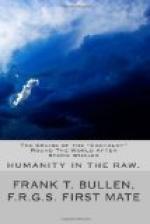Favoured by wind and weather, we made an average run of one hundred and eighty miles per day for many days, paying no attention to “great circle sailing,” since in such a slow ship the net gain to be secured by going to a high latitude was very small, but dodging comfortably along on about the parallel of 48deg. S., until it became necessary to draw down towards “Cape Stiff,” as that dreaded extremity of South America, Cape Horn, is familiarly called by seamen. As we did so, icebergs became numerous, at one time over seventy being in sight at once. Some of them were of immense size—one, indeed, that could hardly be fitly described as an iceberg, but more properly an ice-field, with many bergs rising out of it, being over sixty miles long, while some of its towering peaks were estimated at from five hundred to one thousand feet high. Happily, the weather kept clear; for icebergs and fog make a combination truly appalling to the sailor, especially if there be much wind blowing.
Needless, perhaps, to say, our look-out was of the best, for all hands had a double interest in the safety of the ship. Perhaps it may be thought that any man would have so much regard for the safety of his life that he would not think of sleeping on his look-out; but I can assure my readers that, strange as it may seem, such is not the case, I have known men who could never be trusted not to go to sleep, no matter how great the danger. This is so well recognized in merchant ships that nearly every officer acts as if there was no look-out at all forward, in case his supposed watchman should be having a surreptitious doze.
Stronger and stronger blew the brave west wind; dirtier, gloomier, and colder grew the weather, until, reduced to two topsails and a reefed foresail, we were scudding dead before the gale for all we were worth. This was a novel experience for us in the cachalot, and I was curious to see how she would behave. To my mind, the supreme test of a ship’s sea-kindliness is the length of time she will scud before a gale without “pooping” a sea, or taking such heavy water on board over her sides as to do serious damage. Some ships are very dangerous to run at all. Endeavouring to make the best use of the gale which is blowing in the right direction, the captain “hangs on” to all the sail he can carry, until she ships a mighty mass of water over all, so that the decks are filled with wreckage, or, worse still, “poops” a sea. The latter experience is a terrible one, even to a trained seaman. You are running before the wind and waves, sometimes deep in the valley between two liquid mountains, sometimes high on the rolling ridge of one. You watch anxiously the speed of the sea, trying to decide whether it or you are going the faster, when suddenly there seems to be a hush, almost a lull, in the uproar. You look astern, and see a wall of water rising majestically higher and higher, at the same time drawing nearer and nearer.




